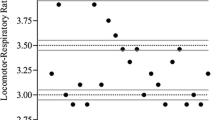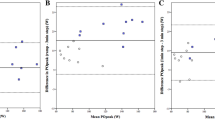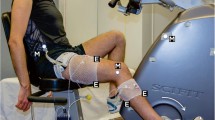Abstract
The purpose of this study was to examine mechanical efficiency (ME) and physiological responses during asynchronous (the pedal arms oriented in opposing directions) arm-cranking exercise (AACE) and compare these responses to those obtained during synchronous (the pedal arms oriented in the same direction) arm-cranking exercise (SACE). Ten male subjects participated in the study and performed two exercise tests, one AACE and the other SACE in counter-balanced order. Each test consisted of submaximal (30, 60 and 90 W) and maximal exercise. At 30 W, gross ME was significantly lower during SACE compared to AACF, whereas at 60 W and 90 W no differences between the two types of exercise could be observed. We found that at lower power output levels the flywheel mass and its moment of inertia may have induced more body movements for compensation, which may have been more pronounced during SACE than during AACE. At higher levels of power output this flywheel mass-effect was less, which explained the lack of differences in ME at these levels. Physiological responses to maximal AACE or SACE exercise were not significantly different. The results indicated that there were no differences in physiological responses to AACE and SACE exercise at higher exercise intensities. However, at lower levels of power output ME seemed to decrease, most likely as a result of the flywheel-mass effect, which was more pronounced during SACE.
Similar content being viewed by others
References
Binkhorst RA, Vissers ACA (1983) The influence of flywheel mass and cranklength during arm cranking. In: Standardisierung, kalibrierung and methodik in der ergometrie. Perimed Fachbuch, Erlangen, pp 60–64
Carter R, Coast JR, Idell S (1992) Exercise training pulmonary disease. Med Sci Sports Exerc 24:281–291
Casaburi R, Barstow ThJ, Robinson T, Wasserman K (1992) Dynamic and steady-state ventilatory and gas exchange responses to arm exercise. Med Sci Sports Exerc 24:1365–1374
Cummins TD, Gladden LB (1983) Responses to submaximal and maximal arm cycling above, at and below heart level. Med Sci Sports Exerc 15:295–298
Davis GM (1993) Exercise capacity of individuals with paraplegia. Med Sci Sports Exerc 25:423–432
Franklin BA (1985) Exercise testing, training and arm ergometry. Sports Med 2:100–119
Franklin BA (1989) Aerobic exercise training programs for the upper body. Med Sci Sports Exerc 21:S141-S148
Gaesser GA, Brooks G (1975) Muscular efficiency during steadyrate exercise: effects of speed and work rate. J Appl Physiol 38:1132–1139
Hopman MTE, Oeseburg B, Binkhorst RA (1992) Cardiovascular responses in paraplegic subjects during arm exercise. Eur J Appl Physiol 65:73–78
Kemper HCG, Van Aalst R, Leegwater A, Maas S, Knibbe JJ (1990) The physical and physiological workload of refuse collectors. Ergonomics 33:1471–1486
Linden AL, Holland GJ, Loy SF, Vincent WJ (1993) A physiological comparison of forward vs reverse wheelchair ergometry. Med Sci Sports Exerc 25:1265–1268
Powers SK, Beadle RE, Mangum M (1984) Exercise efficiency during arm ergometry: effects of speed and work rate. J Appl Physiol 56:495–499
Sawka MN (1986) Physiology of upper body exercise. Exerc Sports Sci Rev 14:175–211
Stainsby WN, Gladden LB, Barclay JK, Wilson BA (1980) Exercise efficiency: validity of base-line subtractions. J Appl Physiol 48:518–522
Shephard RJ (1991) Benefits of sport and physical activities for the disabled: implications for the individual and for society. Scand J Rehabil Med 23:51–59
Van Der Woude LHV, Veeger HEJ, Hendrich KM, Rozendal RM, Van Ingen Schenau (1988) Manual wheelchair propulsion: effects of power output on physiology and technique. Med Sci Sports Exerc 20:70–78
Washburn RA, Seals DR (1983) Comparison of continuous and discontinuous protocols for the determination of peak oxygen uptake in arm-cranking. Eur J Appl Physiol 51:3–6
Author information
Authors and Affiliations
Rights and permissions
About this article
Cite this article
Hopman, M.T.E., van Teeffelen, W.M., Brouwer, J. et al. Physiological responses to asynchronous and synchronous arm-cranking exercise. Eur J Appl Physiol 72, 111–114 (1995). https://doi.org/10.1007/BF00964124
Accepted:
Issue Date:
DOI: https://doi.org/10.1007/BF00964124




